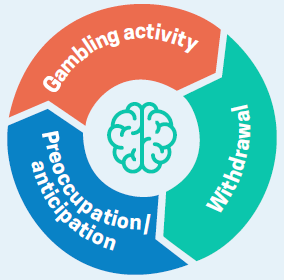2.2 Gambling behaviour: A continuum
We can imagine gambling behaviour as a continuum – some people who gamble will not experience any harm as a result of their gambling, but others may experience several overlapping gambling-related harms.
All gambling carries a risk of harm. People whose gambling behaviour fits certain patterns are more likely to experience harm than others. We can understand gambling behaviour as falling into 3 categories:
- Recreational or ‘lower-risk’ gambling
Gambling occasionally, gambling for entertainment, hoping to win but expecting to lose - ‘At-risk’ gambling
Experiencing feelings of guilt, chasing losses, or betting more than you can afford to lose - People experiencing harmful gambling or gambling disorder
Struggling to control gambling, experiencing impacts on finances, relationships, and/or mental health
People who gamble can be identified as being somewhere along the continuum. Over time, people may move between categories, as their behaviour patterns change.
Figure 8 shows the distribution of gambling behaviour in the UK in 2017.1 Most people who gamble are in the recreational or ‘lower-risk’ category. When a person begins to show higher-risk patterns of behaviour (e.g. chasing losses) or experiences harm from gambling, they would move along this continuum into the ‘at risk’ category. Individuals experiencing harmful gambling are those at the end of the scale, who may struggle to control their gambling and experience difficulties affecting their finances, relationships and/or mental health.
Figure 8: Distribution of gambling behaviour in the UK (2017)
Figure 9 shows online gambling industry profits according to each gambling harm risk category.2 People experiencing harmful gambling or at risk of harm represent almost 60% of industry profits.
Figure 9: Percentage of online gambling industry profits from each risk category
Gambling is a risk-taking behaviour. Many people gamble, and most people’s gambling would be classified as recreational or ‘lower-risk.’ However, even people with ‘lower-risk’ behaviour patterns are more likely to experience negative life outcomes than people who don’t gamble. Because so many people gamble at this lower level of risk, research indicates that the harm from ‘lower-risk’ gambling has a bigger impact on public health than harm from ‘at-risk’ or disordered gambling.3
However, limit-setting and similar behaviour patterns can help gamblers to reduce their risk of experiencing harm. For more information on harm reduction, see Chapter 3.
Lower-risk behaviour patterns:
- Gambling occasionally
- Hoping to win but expecting to lose
- Gambling for entertainment
- Setting and sticking to limits of time and money
- Knowing when to walk away
Higher-risk behaviour patterns:
- Expecting to win
- Chasing losses
- Spending more time gambling and thinking about gambling
- Gambling to earn money or escape problems
- Gambling more than you can afford to lose
- Borrowing or stealing to fund gambling
The cycle of gambling disorder
Gambling disorder is a pattern of gambling behaviour that causes significant distress or impairment to important personal functions, where the person experiences impaired control over gambling.
People with a gambling disorder experience a series of changes to the way their brain works, similar to the way the brain changes as a result of substance use disorder. We can understand these changes as occurring in a cycle, that starts with participating in a gambling activity.
Gambling Disorder Cycle

- Fast release of ‘feel-good’ chemical dopamine in the brain
- Habit formation
-
Preoccupation with gambling
-
Cues in the environment act as a trigger: impulse control is numbed, craving is hyperactivated
-
Need to gamble more to get the ‘buzz’ or chase losses
-
Stress system in the brain activated
-
Escaping stress symptoms motivates craving to gamble
Stage 1: Gambling activity
- Person experiences fast release of ‘feel-good’ chemical dopamine in the brain
Our brains are designed to seek rewards. Gambling and other addictive products (like alcohol or drugs) affect the primitive bit of the brain, where the brain is looking for immediate reward without thinking about the long-term, and they ‘hijack’ that reward system by flooding it with dopamine in a way that the primitive brain wasn’t designed to handle.4 - Habit formation
Over time, the intensity of this dopamine release can affect your brain’s ability to experience pleasure from other, more everyday, activities like spending time with friends or family. This is because the pleasure receptors for these more everyday activities (D2 receptors) are suppressed by the floods of dopamine your brain is exposed to through gambling.5
Stage 2: Withdrawal
- Need to gamble more to get the ‘buzz’ or chase losses
Over time, some people begin to build a tolerance, and need to gamble more often, or with more money, or at riskier stakes, to experience the same ‘buzz’ or out of a feeling that they need to chase losses.6 - Stress system in the brain activated
This leads to less experience of the ‘buzz’ or reward, and an activation of the stress system. Stress symptoms include: irritability, restlessness, loss of motivation, disappointment, guilt, depression/ hopelessness, loss of control, anxiety/panic.7 - Stress symptoms motivate craving to gamble
Experience of these negative emotions and physical states motivates you to get rid of them by gambling, leading to craving.
Stage 3: Preoccupation/anticipation
- Preoccupation with gambling
Persistent desire or craving, combined with a need to cope with negative emotions and harms, leads to repeated gambling with bigger amounts of money. - Cues in the environment act as a trigger: impulse control is numbed, craving is hyperactivated
In people experiencing disordered gambling, external cues like ads trigger the habit-seeking, emotional brain system, and numb the impulse control system. Brain imaging studies show that the area of the brain responsible for impulse control (pre-frontal cortex) is less active in people experiencing addiction – this interferes with decision-making, self-regulation, and working memory.8
m
Discussing the motivations that might lead someone to gamble can be a good way to engage young people in conversations around gambling and gambling harm. It can also help to understand the psychological needs that someone may be trying to fulfil if they choose to gamble, which opens up an opportunity to consider safer alternatives for meeting those needs.
Motivations to gamble can vary a lot between people, and a person might have more than one motivation for gambling. Common motivations include:9
- Enjoyment
Gambling might be something a person does ‘for a bit of fun,’ as a form of entertainment, or something they see as ‘a little treat.’ - Excitement
Wins, near misses, and mechanics of gambling activities like flashing lights can mean it gives a person a ‘buzz of excitement.’ - To escape negative emotions or cope with trauma
When a person gambles, they may feel focused or ‘in the zone,’ which can distract them from negative emotions or impacts from trauma they may have experienced in their lives. - To make money
A person might hope that ‘winning big’ will offer an easy way to make money, or to escape debt or fund a way out of a difficult life situation. - Feeling lucky or fear of regret
If a person feels that a ‘lucky chance has come my way,’ or they routinely place a certain bet or numbers on the lotto, they may feel they will miss out if they do not participate. - Peer approval
Even if a person is not interested in gambling themselves, they may take part as ‘a way I get to enjoy being with others.’ - Fear of missing out
Seeing other people doing or enjoying something, especially on social media, can lead to a fear that ‘I will be the only person who doesn’t have this experience that could make my life better.’ - To test their skills
For a person who sees gambling as a matter of skill, they may feel confident that they will win, and see it as ‘an opportunity to test my skills.’
Beyond a person’s own motivations, their circumstances and surroundings can also influence their gambling behaviour. For example:
- Advertising
Exposure to gambling ads can act as a constant reminder and push to gamble. Young people with higher exposure to ads are more likely to say they intend to gamble in the future.10 Young people are increasingly exposed to gambling through social media influencers and platforms like Twitch. - Awareness
Being more familiar with, and aware of, different types of gambling or gambling brands can influence behaviour. Young people with higher awareness of gambling brands are more likely to currently gamble.11 - Acceptability and social norms
The society we live in influences our behaviour. In societies where gambling is ‘normalised,’ the activities and harms associated with gambling are seen as acceptable and ordinary. This means that gambling behaviour may be passed down as a part of life to each generation, through their upbringing and socialisation.12 - Accessibility
If we are surrounded by opportunities to gamble, both in person and online, this makes it easier to participate. For example, gambling venues are more likely to be located in deprived areas,13 and people who live near to gambling venues are more likely to gamble and experience harm.14 - Affordability
For some people, having a bit of money to spare can mean they are more likely to gamble. In contrast, if you are struggling to make ends meet, gambling may be seen as a possible way out of financial difficulty. - Age
A person’s age is linked to several of the above factors, including affordability and accessibility. In the UK, most forms of gambling are age-restricted, which impacts their accessibility. Among children and young people, older young people and young adults are more likely to gamble.15
